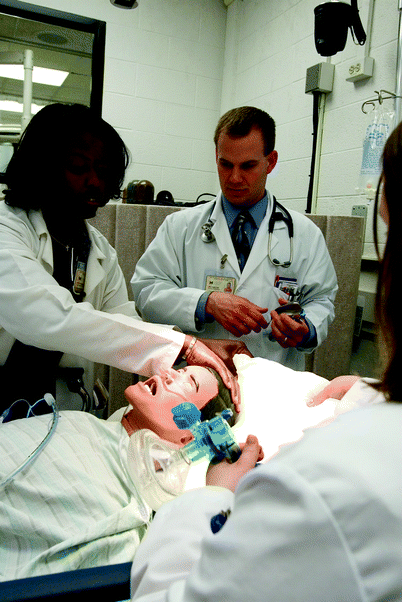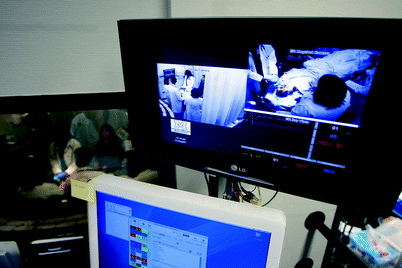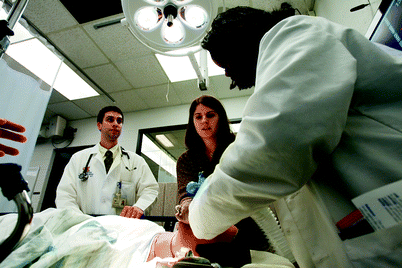Fig. 22.1
Web-based, interactive scenario designed for use by medical students during their third-year clinical clerkship in family medicine. The dyspepsia case (shown) addresses several learning objectives embedded within the Society for Teachers of Family Medicine (STFM) Family Medicine Clerkship Curriculum. Image used with permission of the author, Dr. Joel Heidelbaugh, and available at http://www.med-u.org/virtual_patient_cases/fmcases
Residency Programs
At the residency level, the use of simulator-based training has expanded in recent years, moving beyond procedural instruction to address a more complex array of patient management topics and skills that relate to the delivery of team-based care to patients (e.g., professional communication, team leadership). Clinical simulation has been embraced by some programs for advanced cardiac life support, neonatal advanced life support, and advanced life support for obstetrics as well as for procedural and critical care training (Figs. 22.2, 22.3, 22.4, and 22.5). Advancements in team training, team management, ethics, and other complex patient care issues are emerging [31, 32]. Table 22.1 contains a comprehensive list of modalities applicable to family medicine. Table 22.2 provides an overview of published curricula that can be tailored to the needs of individual programs and learner needs.





Fig. 22.2
Family medicine residents work as a group on manual endotracheal intubation skills prior to rapid sequence intubation team training

Fig. 22.3
Residents participate in a simulated respiratory distress scenario to demonstrate team communication skills, delegation of tasks, supervision, and efficient diagnosis and treatment

Fig. 22.4
The instructors view from the control room of a simulation center

Fig. 22.5
The realism, or fidelity, of the simulation suite, materials, and scenario can promote a high level of learner activation and engagement
Table 22.1
Topics and simulation modalities applicable to family medicine
Clinical skills |
History (standardized patient) |
Physical examination (heart, lung, breast, prostate, cervical dilation) |
Diagnostic ultrasound (obstetric, vascular, abdominal) |
Medical knowledge |
Case-based medical and surgical scenarios (ABFM self-assessment modules, EKG evaluation, radiology) |
Team-based training |
Mobile training in native clinical environments |
Respiratory failure |
Code or rapid-response team leadership and communication |
Cardiac arrhythmia and arrest |
Shock (anaphylactic, cardiogenic, septic, hemorrhagic, neurogenic) |
Disaster preparedness (multiple trauma, terrorism, biological and chemical warfare) |
Conscious sedation |
Neonatal resuscitation |
Obstetric emergencies |
Assisted vaginal delivery |
Procedures |
Basic life support |
Airway management (endotracheal, nasotracheal, or non-visualized intubation, cricothyroidotomy, tracheostomy) |
Vascular access (IV, arterial puncture, arterial cutdown, umbilical, intraosseous, or central line) |
Endoscopy (colonoscopy, sigmoidoscopy, EGD, endoscopic biopsy) |
Nasolaryngoscopy |
Laparoscopy |
Arthrocentesis |
Thoracentesis/paracentesis with or without ultrasound guidance |
Lumbar puncture |
Chest tube placement |
Circumcision |
Other |
Ethics (post-intubation DNR discovery, withdrawal of care) |
Toxicology |
Managing differences of medical opinion in critical situations |
Wilderness medicine or rural trauma |
Table 22.2
On-line resources for family medicine simulation scenarios and curricula
American Board of Family Medicine Self-Assessment Modules (SAMs) for on-line outpatient-based knowledge assessment simulations available to family medicine residents and certified attending physicians at www.theabfm.org |
Family Medicine Digital Resource Library at www.fmdrl.org (maintained by the Society for Teachers of Family Medicine) |
Critical Care Simulation Curriculum, by James Cooke, M.D. www.fmdrl.org/794 |
Simulation Scenarios (OB), by Douglas Maurer, D.O. et al. http://www.fmdrl.org/2145 |
Cardiac Exam Simulation Curriculum, by James Cooke, M.D. http://www.fmdrl.org/3179 |
A Foundation for Procedure Acquisition and Competence using On-line Resources, Individualized Education, and Simulation, by Beth Fox, M.D. http://www.fmdrl.org/3368 |
Role of simulation laboratory in medical student’s education during family medicine clerkship, by Wessam Labib, M.D., M.P.H. http://www.fmdrl.org/3388 |
fmCASES – Family Medicine Computer-Assisted Simulations for Educating Students, on-line case-based simulations for clerkship students www.med-u.org/virtual_patient_cases/fmcases |
MedEdPortal www.mededportal.org (maintained by the Association of American Medical Colleges) – 191 listed simulation curricula, scenarios, and web-based modules as of 2011 including medical and dental cases at every level of training |
Society for Academic Emergency Medicine (SAEM) Simulation Case Library http://www.emedu.org/sim |
Educators can shape simulation exercises to address program-specific, organizational, or community-based needs. If a residency curriculum lacks certain procedural training opportunities, simulation can be used as an adjunct to expand residency skill development. Hospitals may choose to use simulation during staff orientation as a method of promoting uniformity in first-responder skills and transfer protocols. Travel or in situ simulation programs can enhance multidisciplinary training of residents, nurses, pharmacists, respiratory therapists, and other healthcare team members because they can be physically located in or near patient care areas where team communication, supervision, and performance takes place. Given the large number of clinical care environments encountered by family medicine residents and the large number of colleagues and staff with whom the residents must interact, it is essential that they learn and apply standard concepts in team resource management to optimize patient safety and clinical outcomes. Simulation provides an ideal tool for such training.
The simulation center is, in many ways, becoming the bench lab for educators, with significant potential for impact on family medicine. Many residency programs have been studying simulation-based training to determine best practices for training as well as formative and summative evaluation. A hybrid approach to procedural skills training, using both standardized patients and simulators, has been used for obstetrics and endoscopy training to incorporate interpersonal communication skills. Large group simulation for pandemic planning and mass casualty scenarios have been advocated by emergency medicine and military physician groups and will likely prove well suited to the training of primary care providers in the coming years.
Within family medicine, the number of research studies and national conference presentations has increased in recent years, with a focus on topics such as resident perceptions and acceptance of simulation for critical care training [33], improvement in endoscopy skills [15], pediatric life support [17], adult intubation [19], and medical decision-making. We anticipate more discussion of best practices and validation studies of assessment tools linked to clinical competencies as simulators are more widely utilized. We also anticipate that incoming residents will begin to factor the availability of simulation experiences into their selection of residency programs during the match process especially as more students have exposure to simulator training during medical school.
Certification Examinations and Renewals
The American Board of Family Medicine has recognized the importance of translating knowledge into practice by adopting case-based, computer simulations as part of its certification and recertification examinations and annual maintenance of certification (MOC) modules. Beginning in 2004, the MOC modules were modified to include a wide variety of inpatient and outpatient medical scenarios, from well child care and maternity care to care of the vulnerable elderly (see Table 22.3). Diplomates are expected to complete one module per year. Each module contains a knowledge test, evidence-based competency measures, and a computer-simulated patient scenario that extends from an initial visit through ongoing management of a chronic medical condition. Physicians receive an image of a patient and a presenting complaint. After entering free-text diagnostic questions into the module program, they elicit and review physical exam findings. The simulator sequence allows physicians to order office-based studies and laboratory tests, utilize a working problem and diagnosis list, and recommend treatment. Follow-up visits are sometimes embedded in the module sequence and require that physicians engage in additional history taking, physical examinations, diagnostics, and/or therapeutic recommendations. At the end of each simulation, the physician receives a performance evaluation and evidenced-based feedback based on published data and guidelines.
Table 22.3
Self-assessment modules offered for maintenance of certification by the American Board of Family Medicine
Care of the vulnerable elderly |
Cerebrovascular disease |
Childhood illness |
Coronary artery disease |
Depression |
Diabetes |
Health behavior |
Heart failure |
Hypertension |
Maternity care |
Pain management |
Preventive care |
Well child care |
To date, research on the use of simulators for physician certification has focused primarily on perceptions of the certification process and estimation of its impact on future practice behavior [34]. Additional outcomes data will become available as the volume of family medicine physicians who have completed the annual self-assessment module (SAM) increases.
Continuing Medical Education
The use of simulation for continuing medical education (CME) is limited. Some research supports the integration of clinical simulation with traditional learning techniques at CME courses to allow physicians to practice newly introduced techniques and concepts [35]. Such training could involve longitudinal experiences using scenarios that replicate a clinical practice setting to promote deeper learning and better application to patient care.
While simulation is used in the delivery of bioterrorism and disaster training for healthcare providers, it could also be quite useful for retraining physicians who have had an extended leave of absence from medical practice. The benefits of retraining are probably most applicable to higher-risk care, such as hospital care, critical care, obstetrics and procedural training. Other educational and safety initiatives using patient simulation include: realistic reenactments of critical events [36], multidisciplinary in-hospital mock codes, and education on the use of new medical equipment or new skills [37]. Despite lack of supporting evidence, several hospitals, medical groups, and malpractice insurers are beginning to mandate such training based solely on its perceived benefits. Some malpractice insurers now provide financial incentives to physicians who complete simulations that emphasize error avoidance and team communication. This is encouraged due to the perceived safety benefits for patients as well as the potential financial benefit to the insurers [32].
Assessment and Evaluation
To review the use of simulation as a vehicle for assessment and evaluation, we must consider the smaller studies in family medicine in combination with those from other medical specialties. In a recent meta-analysis that included 609 eligible studies enrolling 35,226 healthcare professional trainees, Cook and colleagues found that the use of technology-enhanced simulation training had large effects on measured knowledge, skills, and behaviors and moderate effects for patient-related outcomes when compared to no intervention [38]. This argues for the increased use of simulation, but family medicine educators still need to determine which knowledge, skills, or attitudes are best suited to simulation and the extent to which this varies by learner education level.
Evidence from the surgical specialties has validated several measures of resident procedural competence, such as cecal intubation time for colonoscopy and efficiency of movement and procedure time for laparoscopic cholecystectomy using high-fidelity endoscopic and laparoscopic simulators. These procedural skills are relatively easy to isolate and evaluate in a controlled simulation environment. In contrast, evaluating primary care resident competency in the management of respiratory distress is a much more complex undertaking. To determine competence, one must simultaneously assess multiple communication, physical exam, diagnostic reasoning, therapeutic decision-making, and procedural skills. Validated checklists have been developed to assess the evaluation and management of apnea, asthma, supraventricular tachycardia, and sepsis by pediatric residents [39], but the challenge remains to define a core group of skills and develop valid assessments for the wide variety of patients and medical conditions encountered in family medicine.
The value of providing standardized scenarios linked to validated evaluation tools holds significant promise in primary care in general and family medicine residency in particular because traditional observational methods employed in the clinical setting are fraught with potential bias and inaccuracy. This is due, in part, to time constraints placed on faculty and residents attributable to competing needs and demands in the clinical environment. It is also due to a lack of standardized faculty training in direct observation.
Studies are underway to help define clinical simulation competencies using several objective measures, including diagnostic accuracy and length of time from diagnosis to the delivery of effective treatment [40, 41]. Future research on validity will be needed as we begin to adopt standardized competency measures instead of simply using prior experience as an indicator of skill acquisition. While documentation of the number of cases managed (e.g., congestive heart failure or acute MI) or number of surgical procedures performed (e.g., sigmoidoscopy) traditionally served as indicators of skill competency, we may soon be able to use measures such as time to diagnosis a medical condition or percent of mucosa visualized during endoscopic procedures as more accurate determinants of clinical competence or procedural expertise.
Indeed, one can imagine future physicians reporting their simulation-based procedures to augment their actual case numbers or simulator-measured metrics to document competency for procedures or hospital credentialing. Validated assessment tools are needed to measure the impact of simulation-based learning on clinical practice behavior across a range of clinical competencies, care settings (e.g., inpatient, outpatient, home, skilled nursing facility), and patient populations (e.g., geriatric, adult, pediatric, obstetric). Family medicine educators should be prepared for the eventual incorporation of clinical simulation competency milestones into residency program accreditation requirements.
The Art: Addressing Challenges and Maximizing Benefits
Challenges for Implementation
To date, relatively few articles on simulator-based education have been published in the primary care literature [42] despite demonstrated interest and the previously proven benefit of standardized patients in medical education [43, 44]. Similarly, no requirements for the incorporation of simulation into medical school and residency education have been articulated by the Liaison Committee on Medical Education (LCME) or the ACGME. This apparent deficit in the literature is likely due to a combination of factors. Many faculty members lack personal experience with (or exposure to) clinical simulation training, and access to simulation center facilities is not yet widely available [14]. Because the use of simulation-based training in family medicine is a relatively recent development, fully elaborated curricula are just beginning to emerge and data on instructional outcomes remain scarce. Also, many family medicine programs lack access to a clinical simulation center, the establishment of which comes at a high cost that likely falls outside of many program budgets. Although reported annual operating expenses for teaching hospital-based or medical school-based simulation centers vary widely (ranging from less than $250,000 to over one million dollars), these estimates do not include the initial start-up costs [14].
Stay updated, free articles. Join our Telegram channel

Full access? Get Clinical Tree








